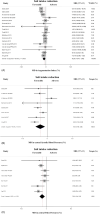Effect of dietary salt restriction on central blood pressure: A systematic review and meta-analysis of the intervention studies
- PMID: 32271997
- PMCID: PMC8029708
- DOI: 10.1111/jch.13852
Effect of dietary salt restriction on central blood pressure: A systematic review and meta-analysis of the intervention studies
Abstract
Central blood pressure (cBP) is highly associated with cardiovascular risk. Although reduction of salt intake leads to lower peripheral blood pressure (BP), the studies on cBP provided inconsistent results. Therefore, we performed a systematic review and a meta-analysis of the available intervention trials of salt reduction on cBP values to reach definitive conclusions. A systematic search of the online databases available (up to December 2018) was conducted including the intervention trials that reported non-invasively assessed cBP changes after two different salt intake regimens. For each study, the mean difference and 95% confidence intervals were pooled using a random-effect model. Sensitivity, heterogeneity, publication bias, subgroup, and meta-regression analyses were performed. Fourteen studies met the pre-defined inclusion criteria and provided 17 cohorts with 457 participants with 1-13 weeks of intervention time. In the pooled analysis, salt restriction was associated with a significant reduction in augmentation index (9.3%) as well as central systolic BP and central pulse pressure. There was a significant heterogeneity among studies (I2 = 70%), but no evidence of publication bias. Peripheral BP changes seemed to partially interfere on the relationship between salt restriction and cBP. The results of this meta-analysis indicate that dietary salt restriction reduces cBP. This effect seems to be, at least in part, independent of the changes in peripheral BP.
Keywords: augmentation index; central blood pressure; meta-analysis; pulse wave analysis; salt; sodium intake.
© 2020 Wiley Periodicals, Inc.
Conflict of interest statement
LD was a technical advisor to the World Health Organization and is a member of the scientific committee of the Italian Society of Human Nutrition. PS is an unpaid member of WASH, scientific coordinator of the Interdisciplinary Working Group for Reduction of Salt Intake in Italy (GIRCSI), and member of the committee for the preparation of the Italian Nutritional Guidelines. The remaining authors do not disclose any conflict of interest.
Part of the preliminary study data was previously presented at the British and Irish Hypertension Society 2019 Meeting.
Figures


References
-
- Roman MJ, Okin PM, Kizer JR, Lee ET, Howard BV, Devereux RB. Relations of central and brachial blood pressure to left ventricular hypertrophy and geometry: the strong heart study. J Hypertens. 2010;28:384‐388. - PubMed
-
- Jankowski P, Kawecka‐Jaszcz K, Czarnecka D, et al. Ascending aortic, but not brachial blood pressure‐derived indices are related to coronary atherosclerosis. Atherosclerosis. 2004;176:151‐155. - PubMed
-
- Vlachopoulos C, Aznaouridis K, O'Rourke MF, Safar ME, Baou K, Stefanadis C. Prediction of cardiovascular events and all‐cause mortality with central haemodynamics: a systematic review and meta‐analysis. Eur Heart J. 2010;31(15):1865‐1871. - PubMed
-
- Roman MJ, Devereux RB, Kizer JR, et al. Central pressure more strongly relates to vascular disease and outcome than does brachial pressure: the strong heart study. Hypertension. 2007;50:197‐203. - PubMed
-
- Safar ME, Blacher J, Pannier B, et al. Central pulse pressure and mortality in end‐stage renal disease. Hypertension. 2002;39:735‐738. - PubMed
Publication types
MeSH terms
Substances
LinkOut - more resources
Full Text Sources
Medical
Miscellaneous

